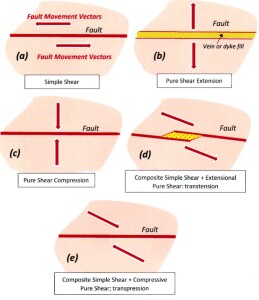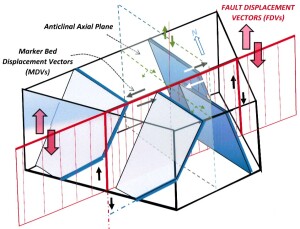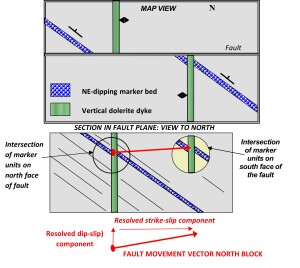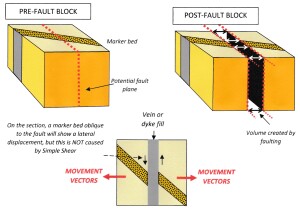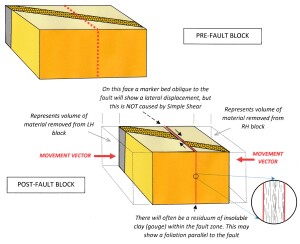The movement of faults
Faults are not mathematical planes (2D surfaces with length and depth but no thickness) but 3D tabular zones of deformed rock. The length and depth of a fault is always much greater than its thickness, but fault width can vary through many orders of magnitude from a fraction of a millimeter to to tens of kilometers.
There is widespread confusion in the geological literature as to the exact definition of a fault. I discuss this in another blog post here.
Small, locally developed, fracture surfaces across which insignificant displacement has taken place are called joints. By “insignificant” I mean difficult or impossible to see with the naked eye. Joints form in the same way as faults and should be regarded as a sub-category of brittle faulting.
No fault is ever strictly planar. Normal and Thrust faults (more on these later) are typically curved: steep dipping near the surface and progressively flattening with depth – a shape known as listric. In addition, at all scales, faults show irregularities – bends and bumps and jogs. During fault movement the variations from strict planarity lead to complex patterns of stress along the fault surfaces. These stress variations are the key to understanding the location and shape of ore that might form within the fault zones.
The method of deformation in a fault can be either brittle or ductile, or, more typically, some combination of brittle and ductile.
Fault Movement Vectors (hereafter FMVs) indicate the direction that any point on one side of the fault trace has been displaced relative to any point on the other side during fault movement. On any plane passing through the FMVs, the FMVs can be shown as a pair of opposed arrows, one for the rocks on either side of the fault.
FMVs can lie at any angle to the fault surface
FMVs can lie at any angle to the fault surface. Where the FMVs are parallel to the fault plane, the fault has formed by a deformation mechanism known as Simple Shear. Where the FMVs are at 90° to the fault surface, the fault was formed through the process of Pure Shear. Where FMVs lie between 0˚ and 90˚ to the fault plane, deformation was accomplished by a mixture of both simple shear and pure shear mechanisms.
In Simple Shear Faults, the rocks on either side of the fault zone have moved laterally with respect to each other. FMVs are parallel to the fault plane.
In Pure Shear Faults, the rocks on either side of the zone have either moved towards each other in compression or moved apart in extension[1]. For this to happen, there must be a reduction or increase in the volume of the rocks affected by the external stress field.
Most fault zones are the result of both simple shear and pure shear deformation styles. The relative proportion of these two processes can vary both across and along the fault zone.
Because changing rock volume is difficult, they deform much more easily by the mechanism of simple shear than by pure shear. Thus, displacements of more than a few meters indicates that the dominant mechanism was probably that of simple shear. Note the deliberate use here of the vague terms: “dominantly”, “more than”, “few” and “probably”. In dealing with real rocks in the field, as opposed to simplified textbook examples, that is the best that can be done.
Because of the above, the most commonly occurring map-scale faults are those where the amount of displacement attributable to simple shear is greatest. For most purposes, and to a first order approximation, map scale faults can be regarded as dominantly simple shear faults.
As rock is incompressible, faulting can only reduce its volume by the physical removal of material from the faces of the fault zone. This happens predominantly by means of selective solution (or in extreme cases, melting) of rock material into fluids within the fault zone. The process is promoted by high temperature and high confining pressure and controlled by the chemical/mineralogical nature of the affected rocks. The dissolved material in solution moves along (laterally and upwards) the fault zone. Movement is driven by pressure and temperature gradients as well as by the “pumping” effects of periodic seismicity[6]. It will ultimately be deposited as vein material (typically quartz or calcite) elsewhere in the fault in regions that are under relative tension. Left behind in the fault zone are the relatively insoluble rock components such as clay or graphite. Any puggy, clay-rich material in a fault is the insoluble residuum of material lost through pressure solution during pure shear compression. This type of fault fill is usually described as fault gouge.
In the upper few kilometers of the earth’s crust, where confining pressure and temperature are relatively low, rocks have little strength under tension. Pure shear extension stress creates fractures – planar zones of extension – that (unless at or near the surface) will suck in fluids from along the fault zone or from adjacent rocks. The presence of such pressurized fluids can aid the propagation of a tensional fracture. The fluids deposit vein material in the fracture. Igneous fluids (magma) may crystallize as dykes or sills. Vein filled zones in former tensional sites of a fault are the so-called “dilational jogs” that host many epithermal ore deposits.
The important point to remember is that pure shear deformation, as opposed to simple shear deformation, always results in a change in volume – either an increase or a decrease – of the affected rocks.
Figure 1: The diagram shows a series of two-dimensional slices through rocks affected by different dynamic styles of faulting. The red opposed paired arrows are the Fault Movement Vectors and indicate the relative net movement of any point on either side of the fault trace. The sections are all in the plane of the FMVs. Where the vectors are parallel to the fault plane (as in a), the opposed blocks have moved laterally past each other: sinistral if to the left (as shown) or dextral if to the right. However, FMVs can lie at any angle to the fault plane. Where FMVs point towards each other, and are not parallel to the fault plane, the stress state is known as trans-pression; if the arrows point away from each other, and not parallel to the fault plane (b), the stress state is known as trans-tension. Two end member states, either of pure compression or pure extension, occur where the vectors are normal to the fault (b & c). There is a continuum between these different styles of fault movement, not just between different faults, but within any one fault at different places and at different times during its formation. Click for a larger, sharper image.
Simple shear and pure shear faults are end members of a continuum of styles of displacement across a fault. Even where simple shear might be the predominant mechanism, different parts of the fault will locally exhibit the effects of pure shear. Conversely, in dominantly pure shear structures, there will be zones where the structures observed formed through the mechanism of simple shear.
Faults develop incrementally over geological time through the accumulation of large numbers of relatively small movements. During this process, each part of a final fault structure may have been sequentially subjected to, and show the effects of, both displacement mechanisms. Therefore, in addition to evidence for different structural structural styles that operated in different parts of a fault at any one time, at any one point in a fault different styles of faulting may have operated over time. Typically, early formed structures are destroyed by later movement, but this is not always the case.
The displacement of marker beds
Any marker bed intersected by a fault will be displaced by an amount which depends on the angle which the bed makes with the plane which contains the FMVs. If the angle is 0˚ there will be no apparent lateral displacement of the bed across the fault on any section. The amount of lateral displacement will increase with increasing angle. Maximum displacement is reached when the angle is 90˚. On figure 2 below, the FMVs are parallel to the fault plane. The blue marker beds intersect the fault plane at an angle of around 45⁰ to the FMVs, both to the east and to the west. The vertical anticlinal axial plane (green dash line) makes an angle of 0⁰ with the FMVs. Fault movement thus displaces the marker beds to the east and to the west, but has no apparent effect on the axial plane.
This is a simple geometrical consequence and applies whether the fault mechanism is simple shear or pure shear.
Figure 2: Block diagram of a vertical simple shear fault (red) with S block down displacement. The fault displaces a marker bed (blue) that dips to E and W on opposite limbs of an upright anticline. On all sections parallel to the Fault Movement Vectors (i.e. any vertical section) the displacement of all marker beds or structural planes is the same, irrespective of orientation, and is parallel to the FMVs. When the structures are viewed on any section that is not in the vertical plane (in this example, the plan or map view) differently-oriented structures will show differing amounts, or even sense, of displacement. Click for a larger, sharper image.
The displacement of a single plane across a fault is incapable of providing the FMVs for the fault.
However, the displacement of a unique linear structure across a fault plane will provide a measure of the FMVs. A frequently occurring linear structure is the line of intersection of two differently oriented marker beds. Even although not directly observed, the line of intersection of the marker beds can be easily calculated and its intersection with the fault plane plotted. In the map and section shown in figure 3 below, the intersection of a NE-dipping bed (blue) and a vertical dyke (green) on either side of a fault defines two displaced points across the fault. The line joining the points is the Fault Movement Vector. In this example it has a sinistral strike slip movement (70%) plus a small component (30%) of dip-slip S-block down movement. The analysis only works, of course, if the FMVs lie within the plane of the fault (i.e., a simple shear fault).
Figure 3: The displacement of a point across a simple shear fault defines the Fault Movement Vector.
Simple rules for interpreting simple shear faults
For a first pass interpretation of any geological section across a simple shear fault:
- On any section or plan, if marker units of differing orientation are displaced in the same sense and by the same amount, then that section or plan must lie in the plane of the FMVs for that fault.
- On any section or plan, if marker units of differing orientation are displaced by different amounts and/or in different senses, then that section or plan must lie at an angle other than zero to the FMV plane for that fault. From which it follows that:
- In a horizontal section (usually called a map) the fault movement is STRIKE-SLIP (i.e. a transcurrent fault) if marker beds of different orientation show the same displacement across it.
- In a vertical section, the fault movement is DIP-SLIP (a thrust or normal fault) if marker beds of different orientation show the same displacement across it.
The descriptive nomenclature of Simple Shear Faults
In faults where the dominant displacement style is that of simple shear, the fault can be described in purely geometrical terms as either strike-slip (where the movement parallel to the strike of the fault), dip-slip (movement parallel to the dip of the fault), or oblique-slip (a direction between dip-slip and strike-slip).
A more fundamental classification of simple shear faults is based on the orientation of the stress axes which cause them. There are three classes: Transcurrent Faults, Normal Faults and Thrust Faults.
Scottish geologist Ernest Anderson who first proposed it in 1905
Transcurrent faults are strike-slip. Normal and Thrust faults are dip-slip. Reverse faults are usually included in this scheme as steep-dipping Thrust faults. This 3-fold classification of faults (four, if you count Reverse faults separately) is sometimes called “Andersonian” after the Scottish geologist Ernest Anderson who first proposed it in 1905[2] The classification reflects the orientation the three orthogonally-resolved principal external stress axes (greatest, least and intermediate) in the upper part of the earth’s crust. Here, these axes are dominantly either parallel to the earth’s surface, or at right angles to it[4]. If the direction of greatest stress is vertical, Normal faults may form; if the intermediate stress direction is vertical, Transcurrent faults may form; if the least stress direction is vertical, Thrust or Reverse faults may form. This is certainly a simplification, but Anderson’s classification of simple shear faults stands up remarkably well.
Consider an orthogonal section across a simple shear fault with a dip-slip displacement that affects a layered sequence whose dip is less than the fault (Figure 3). The fault (if dipping less than 90˚) will separate a hanging wall block from a footwall block. Where the hanging wall has moved up relative to the footwall, such faults are called reverse or, if the dip is less than around 45˚, they are called thrust faults. In all thrust or reverse faults, movement has shortened the affected rock sequence in the horizontal direction but increased it in the vertical direction. There is no volume loss. If reverse or thrust faults affect strata whose dip is shallower than the fault, there will be vertical repetitions of marker beds on any section across it.
In steep drill holes, where there is repetition of stratigraphy, and older units overlying younger, the presence of thrust faulting is indicated.
Where the hanging wall block has moved down relative to the footwall, dip-slip faults are called Normal. With Normal faults, the affected rocks have been extended horizontally and compressed vertically. Where Normal faults affect shallow-dip strata, elements of the sequence might be missing on vertical sections.
In steep drill holes, missing stratigraphy is a good indicator of the presence of normal faulting.
Figure 4: Vertical sections through dip-slip Simple Shear Faults drawn in the plane of the Fault Movement Vectors (red arrows). On the left, Thrust Faults leading to horizontal compression and vertical thickening of a sequence. On the right, Normal Faults leading to horizontal extension and vertical thinning. Click for a larger, sharper image.
Recognizing Dominantly Pure Shear Faults
left-stepping bends in sinistral faults and right-stepping bends in dextral faults are regions of transtension
Transpression and transtension stresses occur where FMVs are at an angle to the fault plane so as to cause either compressive or tensile stress across it. This situation arises at bends in simple shear faults such as the steep portions, or ramps, of thrust faults (transpression) or the steeper dipping portions of normal faults (transtension). In transcurrent or strike slip faults, bends that tend to oppose fault movement (i.e. left-stepping bends in dextral faults or right stepping bends in sinistral faults) are areas of transpression: bends that are congruent with the sense of fault movement (i.e. left-stepping bends in sinistral faults or right-stepping bends in dextral faults) are regions of transtension. Structures typical of regions of transpression are fault gouge, folds, cleavages, thrusts, back-thrusts and flower structures. Structures typical of regions of transtension are vein-filled dilational jogs, normal faults and graben.
left-stepping bends in dextral faults or right stepping bends in sinistral faults are areas of transpression
During their formation, extensional faults move rocks apart and create a new volume which (except at the surface) sucks in fluids from further along the fault zone or from wall rocks. The fluids may be meteoric water or derived from metamorphic processes or an igneous source. The fluids deposit vein material (typically quartz or calcite) or will crystallize as an igneous dyke. The presence of this epigenetic material in the fault plane is the main way of identifying such faults.
Figure 5: Before and after block diagrams along with a plan view of an Extensional Pure Shear Fault (FMVs – red arrows – point away from each other and are at right angles to the fault plane). On the plan view, the displacement of the marker bed (MMVs – black arrows) is not he result of simple shear. Click for a larger image.
A pure shear compressional fault has lost material from the fault face. The presence of clay gouge in the fault zone indicates that material has been lost through pressure solution. Other structures that may be present in the fault zone such as fine penetrative cleavage parallel to the zone margins, are also indicative of compression.
Figure 6: Before and after block diagrams of a pure shear compressional fault (i.e. the FMVs point towards each other and are at right angles to the fault plane). Note that the dextral strike-slip displacement of the marker bed across the fault (MMVs) is not caused by simple shear. Click for a larger image.
First posted November 2013. Modified July 2020, April 2021
[1] I have always found the terms “simple shear” and “pure shear” unfortunate and non-intuitive. For a start, the word “shear” or “shearing” in all non-technical dictionaries refers only to the lateral movement of two bodies past each other. And what is the logic in calling one type of deformation “simple” and one type “pure”? However, the terms are long established and well defined in rock mechanics. We must live with them.
[2] Sibson R H, Moore J McM & Rankin A H 1975: Seismic pumping and hydrothermal fluid flow mechanisms. J Geol Soc London Vol 131, pp 653-659
(3) E M Anderson, 1905: The dynamics of faulting. Trans Geol Soc Edinburgh, vol 8, pt 3
(4) There are good theoretical reasons why this is so, but that explanation lies beyond the scope of this essay.
